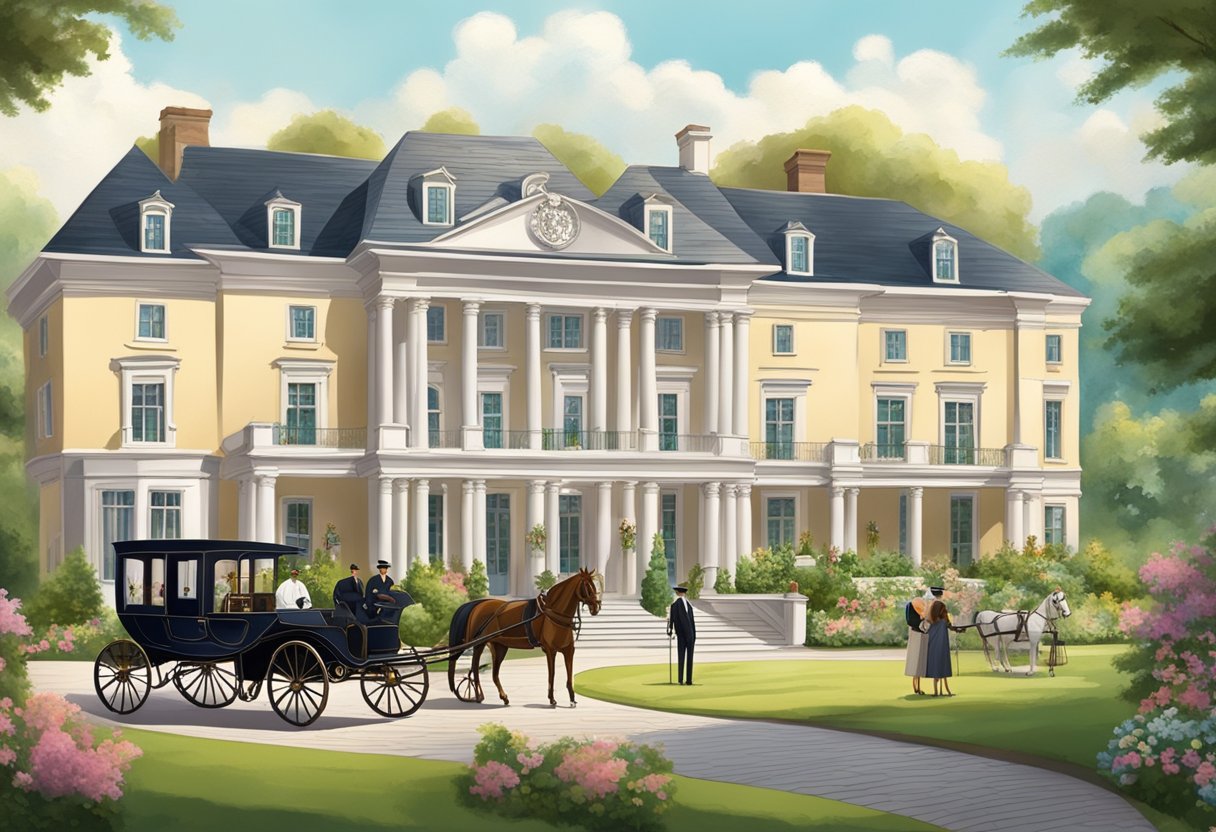Old money refers to wealth that has been inherited and passed down through generations within a family or an established social class. Unlike new money, which is acquired in a short period through entrepreneurship or investments, old money typically represents a lineage of wealth accumulation spanning multiple generations. The concept of old money is often characterized by a strong emphasis on tradition, cultivation of social standing, and adherence to long-standing customs and practices.
The individuals and families associated with old money tend to have a rich historical background, often dating back centuries. This long-lasting wealth accumulation results in a deeply ingrained understanding of financial management and an unwavering commitment to preserving and growing their amassed assets. In many ways, old money is less about the tangible aspects of wealth and more about the cultural and social norms that shape the lives of those born into it.
An air of exclusivity often surrounds old money, as these families generally operate within tight-knit social circles supported by centuries of shared history. Although wealth is a key component, old money values go beyond financial standing, encompassing social etiquette, education, and an appreciation for tradition. By understanding the concept of old money, we can gain insights into the persisting influence of family lineage and the societal norms that drive this integral aspect of the elite class.
Historical Context of Old Money

Origins in Europe and the United States
The concept of “old money” can be traced back to both European aristocracy and early American wealth, where wealth was built upon generations of inheritance and accumulation. In Europe, the old money families often possessed titles, land, and significant influence in both politics and society. They were typically members of the landed gentry or nobility. In the United States, old money families either descended from early settlers who made their fortune in various industries or amassed wealth through landownership, business ventures, or inheritance.
Some key differences between old money in the United States and Europe include the source of wealth and the connection to lineage-regulated institutions (such as the monarchy). In Europe, the old money class had a more extensive history and tie to the nobility, while in the United States, wealth accumulation timeframes were comparatively shorter, and the societal influence of these families was more flexible and allowed for new-money families to integrate more rapidly.
The Gilded Age and Industrialists
The Gilded Age (late 18th to early 19th century) was a significant period for the old money community in the United States. Rapid industrialization and economic growth led to the emergence of a new class of wealthy individuals, often referred to as “captains of industry” or “robber barons.” The vast fortunes accumulated by these industrialists – such as Andrew Carnegie (steel), J.P. Morgan (banking), and Cornelius Vanderbilt (railroads) – enabled their families to join the ranks of old money, wielding a great deal of influence in both politics and society.
During this time, many old money families used their wealth to partake in philanthropy and elevate their social status. Notable examples include the creation of significant institutions such as libraries, museums, and universities by the Rockefellers, Carnegies, and other wealthy families.
From Astor to Rockefeller: Notable Old Money Families
- The Astor Family: John Jacob Astor was the first American multi-millionaire and made his fortune in fur trading, real estate, and opium smuggling. His descendants later became synonymous with high society and luxury in New York City, as they expanded their wealth through real estate and marriage into other wealthy families.
- The Vanderbilt Family: Cornelius Vanderbilt amassed his fortune through interests in steamships and railroads, making the family prominent among old money social circles in New York. They asserted themselves in high society through lavish homes, extravagant parties, and prestigious marriages.
- The Rockefeller Family: John D. Rockefeller made his wealth as a co-founder of Standard Oil Company and, at one point, was considered the richest man in the world. The family has continued to amass wealth and maintain prominence in various fields, from politics to philanthropy.
These families, along with other notable old money families, established themselves as not only wealthy but also culturally influential, setting social norms and trends in their respective societies. This legacy of wealth and influence continues to shape the modern concept of old money today.
Characteristics of Old Money

Traditions and Values
Old Money families have a set of long-standing traditions and values that they adhere to. These values often include a strong emphasis on family, loyalty, and philanthropy. They maintain a low-profile attitude, value privacy and discretion, and engage in various charitable activities for social and cultural causes. Their wealth is often passed down through generations, with an expectation to preserve and grow the family legacy.
Aesthetic and Lifestyle
The Old Money aesthetic and lifestyle are characterized by understated elegance and refinement. Their fashion choices lean towards classic, timeless pieces and subtle color palettes. Properties owned by these families are often large and well-maintained, but not overly extravagant. Old Money homes are known to be filled with antiques, heirlooms, and art pieces that have been passed down through generations. Their lifestyle reflects a preference for quality and durability over ostentation and short-lived trends.
Education and Upbringing
Old Money families place a high importance on education and upbringing. Children from these families often attend prestigious and predominantly Ivy League schools. These institutions are part of the family’s legacy, with many generations having attended the same institutions. Attendance to high-quality preparatory schools is not uncommon. Where emphasis is placed on developing strong academic skills as well as well-rounded character traits.
| Institutions | Legacy Associations |
|---|---|
| Yale | Roosevelt Family |
| Harvard | Kennedy Family |
| Princeton | Forbes Family |
These families often uphold long-standing traditions within their institutions, including social events, clubs, and networking organizations. Allowing their children a wide range of opportunities to excel and establish connections. This education and upbringing prepare them to navigate and maintain their family’s social and financial status.
Financial Practices and Philosophies
Investments and Wealth Management
Old money families generally follow a conservative and long-term approach to investments. Their primary focus is on preserving and growing wealth for future generations. To achieve this, they invest in various assets, such as stocks, bonds, mutual funds, and private equity, with a preference for:
- Blue-chip stocks: Shares in well-established companies with a history of stable earnings and reliable dividends.
- Low-cost index funds: These investments track the performance of market indices, such as the S&P 500, and offer broad diversification at a reduced cost.
- Bonds: Fixed-income investments that provide regular interest income and principal protection, especially government and high-grade corporate bonds.
Additionally, they capitalize on the power of compounding by reinvesting their returns and letting their investments grow over time.
Real Estate and Inherited Wealth
Real estate constitutes a significant portion of old money’s wealth, including land, residential properties, and commercial buildings. Inherited properties, often passed down through generations, might include:
- Historic estates: Grand mansions, castles, or sprawling country homes, often with vast lands attached.
- Prime urban real estate: Buildings in prestigious neighborhoods or central business districts, generating rental income and capital appreciation.
Notably, old money families emphasize the importance of preservation and calculated decisions when managing their inherited wealth. They maintain and improve their properties to ensure their lasting value. They also avoid hasty decisions that might compromise the family’s long-term financial stability.
Spending Habits and Frugality
Old money’s spending habits often reflect a sense of frugality and prudence. They prioritize long-term financial security, steadily building wealth, and living modestly, avoiding debt, and excessive consumption. A few key aspects of their spending philosophy include:
- Living within their means: Old money families avoid living extravagantly, opting for a comfortable lifestyle, without ostentation.
- Preparing for emergencies: By maintaining a healthy emergency fund, old money families ensure that they can weather financial uncertainties and unexpected expenses.
- Education and philanthropy: They invest in their children’s education and contribute to charitable causes, both as a means of giving back and preserving their legacy.
Ultimately, the financial practices and philosophies of old money families are rooted in preserving and growing wealth across generations with calculated decisions, investments, and moderated spending habits.
Social Stratification and Influence
Social Status and the Upper Class
Social status plays a significant role in defining the upper class. The upper class typically consists of individuals and families with substantial wealth, often inherited over generations. They hold prestigious positions in society, as well as unrivaled power and influence. The members of the upper class are referred to as old money due to their long-standing wealth and social standing.
The upper class ranks contain established professionals, aristocrats, and business magnates. Social status can be determined through various factors, including education, occupation, and residential location. These factors contribute to the overall social stratification of society, separating the upper class from the lower and middle classes.
Old Money vs. New Money
There is a distinction between old money and new money (or nouveau riche) in the upper classes. While both possess wealth, their sources of income and societal roles differ. Families and individuals with old money have inherited their wealth through generations, maintaining their social status and influence over time.
On the other hand, new money refers to those who have acquired their wealth recently. Often through entrepreneurship or other financial ventures. Though these individuals may possess great wealth. They may not have the same level of social standing or prestige associated with old money. This can result in a hierarchal divide within the upper class.
A comparison between old and new money can be illustrated as follows:
| Characteristic | Old Money | New Money |
|---|---|---|
| Wealth | Inherited over time | Recently accumulated |
| Prestige | High | Subject to acceptance |
| Power | Historically endowed | Instrumental |
| Social Status | Established | Proving |
Power and Social Events
Both old money and new money individuals participate in elite social events to maintain or enhance their social status. These events serve as a platform for networking and cultivating relationships among the upper class. Attendance at prestigious events, such as exclusive parties, charity galas, and high society balls, reinforces their status within the upper echelons of society.
Social events also allow old money and new money individuals to exercise their power and influence by interacting with other wealthy elites, politicians, and influential individuals. Through these connections, they can affect decision-making and policy changes, further solidifying their influence in society.
Old Money in Contemporary Society
Generational Wealth and Modern Challenges
Generational wealth, often representative of old money, is the financial stability that is passed on from one generation to the next. Inherited wealth from long-established families might include substantial estates, stocks, or other assets.
Despite its prominence, old money families are not immune to modern challenges. The diversification of investment portfolios, economic volatility, and tax implications are just a few issues that these families face. Family dynamics and conflicting goals can also lead to the dissipation of wealth over time.
Philanthropy and Foundations
One of the hallmarks of old money is its involvement in philanthropy, social causes and setting up foundations to aid in their efforts. Many old money families create organizations or foundations focused on:
- Education improvement
- Healthcare advancements
- Environmental conservation
- Social equity
For example, The Rockefeller Foundation and The Ford Foundation are well-established in the philanthropic scene and have made significant impacts on society. Through generous donations and active involvement, old money families continue to contribute to the public good.
Social Media and Public Perception
In today’s digital age, social media has emerged as a powerful tool for shaping public perception. Old money families often maintain a discreet and low-profile presence, cultivating an image of responsible wealth and influence. Some key ways in which they maintain this image include:
- Focus on their philanthropic activities
- Encourage family members to participate in meaningful work
- Uphold traditional values
However, there are instances when the younger generation’s embrace of social media can clash with the family’s traditional low-key approach. Balancing these preferences remains an essential component of managing public perception for old money families.
In contemporary society, old money families must navigate challenges and opportunities arising from generational wealth, philanthropy, and social media’s influence on public perception. Success depends on their ability to adapt to modern times while preserving the legacy and traditions that define it.
Comparative Analysis

Old Money and the Entrepreneurial Spirit
In the context of Old Money, it is essential to understand the relationship with entrepreneurial spirit. Normally, families with old money typically transmit wealth across generations and are generally perceived as conservative. On the other hand, entrepreneurs represent a more contemporary concept of self-made individuals. They often start from humble beginnings and work to achieve wealth through their business ventures and risk-taking behaviors.
Old Money:
- Conservative in nature
- Inherited wealth
- Long-lasting family fortunes
Entrepreneurs:
- Self-made individuals
- Accumulated wealth through business ventures
- Risk-takers
It is noteworthy that there is a difference in the attitudes and perceptions of society toward these two groups, which affects the societal image of entrepreneurs and old money families.
Cultural Representations in Literature and Film
One of the most prominent portrayals of the differences between old money and new money can be found in literature, specifically in F. Scott Fitzgerald’s classic novel, The Great Gatsby. This book explores the differences between the lavish lifestyle, status, and outlook of the old money elite in contrast to the strive for success and wealth shown by newer, self-made characters.
Another avenue of cultural representation is in film. Movies often dichotomize old money and self-made individuals, portraying the former as privileged, often snobbish, and traditional, while the latter is depicted as ambitious, hard-working, and adaptable. It is important to note that these portrayals are, of course, subject to the author’s or filmmaker’s perspective and may not be entirely based on reality.
Inequality and Social Mobility
In discussing old money and new money, it is essential to address the underlying issues of inequality and social mobility. Old money families possess a significant advantage in terms of wealth and access to resources. This allows them to maintain their status across generations. These families often hold vast amounts of intergenerational wealth and property, making them less susceptible to economic fluctuations.
Although both groups experience different levels of inequality, the primary distinction lies in social mobility—or the ability for individuals to ascend (and descend) the social and economic ladder. Often, self-made entrepreneurs must go to extraordinary lengths to achieve upward mobility. By contrast, old money families may enjoy privileges that enable them to hold and accumulate wealth without extraordinary efforts.
It’s important to note that the issue of inequality and social mobility varies from country to country, being highly dependent on factors such as government policies and cultural values. Regardless, understanding the disparities between old money and entrepreneurs remains critical for a comprehensive analysis of wealth distribution throughout society.
Conclusion

“Old money” encapsulates a socio-economic concept that extends beyond mere wealth accumulation. It embodies a legacy of generational affluence, often rooted in established family pedigrees and inherited financial stability. With its historical connotations and traditional values, shapes not only the financial landscape but also social dynamics. While the term may connote a certain level of privilege and exclusivity. It also carries with it a sense of responsibility and continuity. Understanding “old money” invites contemplation on the enduring impact of wealth across generations. This reflects the intricate interplay between tradition, heritage, and the perpetuation of financial legacy.
